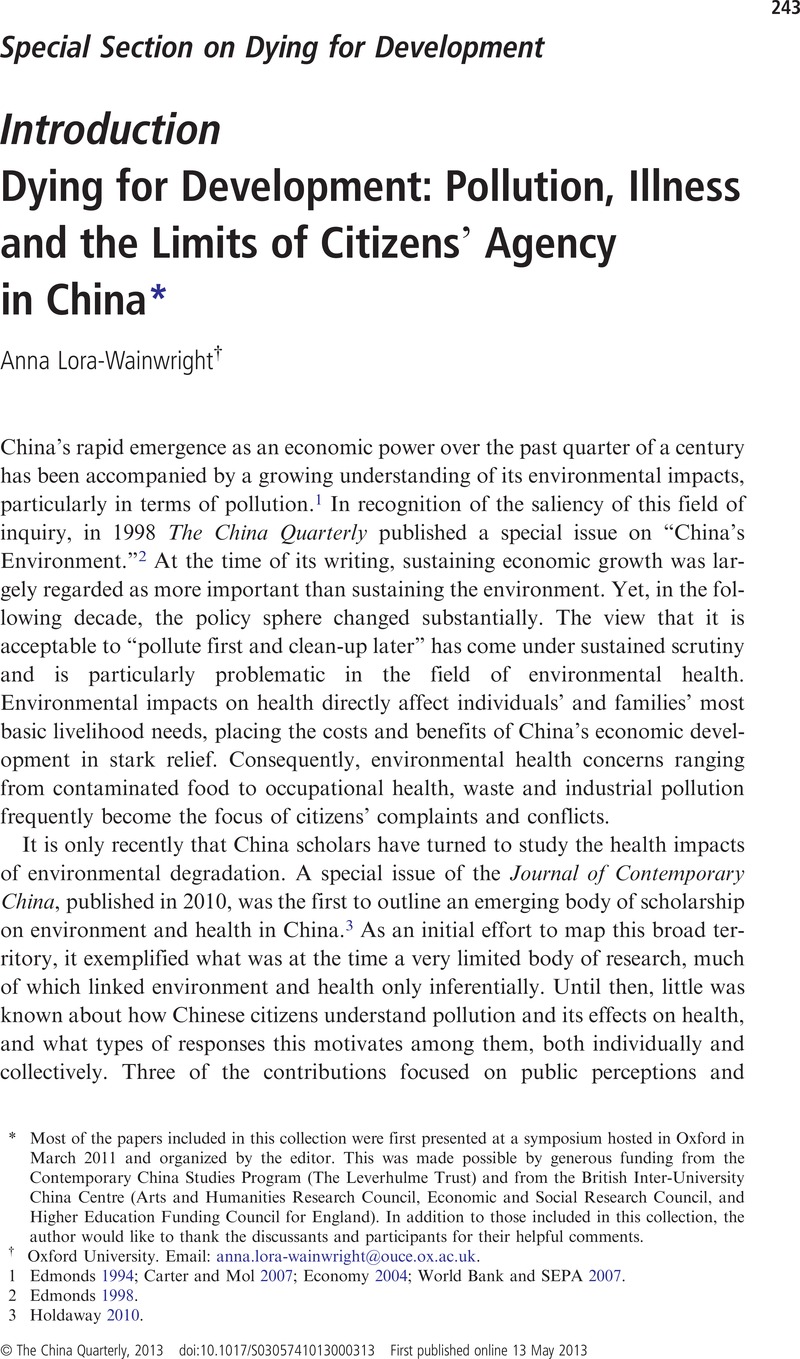Crossref Citations
This article has been cited by the following publications. This list is generated based on data provided by
Crossref.
Jobin, Paul
2014.
Brett L. Walker, Toxic Archipelago: A History of Industrial Disease in Japan.
East Asian Science, Technology and Society: An International Journal,
Vol. 8,
Issue. 4,
p.
499.
Liu, Nicole Ning
Lo, Carlos Wing‐Hung
Zhan, Xueyong
and
Wang, Wei
2015.
Campaign‐Style Enforcement and Regulatory Compliance.
Public Administration Review,
Vol. 75,
Issue. 1,
p.
85.
Grano, Simona A.
and
Zhang, Yuheng
2016.
New channels for popular participation in China: The case of an environmental protection movement in Nanjing.
China Information,
Vol. 30,
Issue. 2,
p.
165.
Grano, Simona A.
2016.
China’s changing environmental governance: Enforcement, compliance and conflict resolution mechanisms for public participation.
China Information,
Vol. 30,
Issue. 2,
p.
129.
Lo, Carlos Wing-Hung
Liu, Ning
Li, Pansy Hon Ying
and
Wang, Wei
2016.
Controlling industrial pollution in urban China: Towards a more effective institutional milieu in the Guangzhou Environmental Protection Bureau?.
China Information,
Vol. 30,
Issue. 2,
p.
232.
Turiel, Jesse
Ding, Iza
and
Liu, John Chung-En
2017.
Environmental Governance in China: State, Society, and Market.
Brill Research Perspectives in Governance and Public Policy in China,
Vol. 1,
Issue. 2,
p.
1.
Ma, Jing
Mitchell, Gordon
Dong, Guanpeng
and
Zhang, Wenzhong
2017.
Inequality in Beijing: A Spatial Multilevel Analysis of Perceived Environmental Hazard and Self-Rated Health.
Annals of the American Association of Geographers,
Vol. 107,
Issue. 1,
p.
109.
Zinda, John Aloysius
Trac, Christine J.
Zhai, Deli
and
Harrell, Stevan
2017.
Dual-function forests in the returning farmland to forest program and the flexibility of environmental policy in China.
Geoforum,
Vol. 78,
Issue. ,
p.
119.
Shen, Yongdong
and
Steuer, Benjamin
2017.
Conflict or cooperation: the patterns of interaction between state and non-state actors in China’s environmental governance.
Journal of Chinese Governance,
Vol. 2,
Issue. 4,
p.
349.
Kostka, Genia
and
Nahm, Jonas
2017.
Central–Local Relations: Recentralization and Environmental Governance in China.
The China Quarterly,
Vol. 231,
Issue. ,
p.
567.
Halskov Hansen, Mette
and
Liu, Zhaohui
2018.
Air Pollution and Grassroots Echoes of “Ecological Civilization” in Rural China.
The China Quarterly,
Vol. 234,
Issue. ,
p.
320.
Geall, Sam
and
Ely, Adrian
2018.
Narratives and Pathways towards an Ecological Civilization in Contemporary China.
The China Quarterly,
Vol. 236,
Issue. ,
p.
1175.
Zinda, John Aloysius
Li, Yifei
and
Liu, John Chung-En
2018.
China’s summons for environmental sociology.
Current Sociology,
Vol. 66,
Issue. 6,
p.
867.
Brombal, Daniele
Niu, Yuan
Pizzol, Lisa
Moriggi, Angela
Wang, Jingzhi
Critto, Andrea
Jiang, Xia
Liu, Beibei
and
Marcomini, Antonio
2018.
A participatory sustainability assessment for integrated watershed management in urban China.
Environmental Science & Policy,
Vol. 85,
Issue. ,
p.
54.
Li, Xiaoyue
and
Tilt, Bryan
2019.
Public engagements with smog in urban China: Knowledge, trust, and action.
Environmental Science & Policy,
Vol. 92,
Issue. ,
p.
220.
Baranovitch, Nimrod
2019.
The Impact of Environmental Pollution on Ethnic Unrest in Xinjiang: A Uyghur Perspective.
Modern China,
Vol. 45,
Issue. 5,
p.
504.
Cockain, Alex
2020.
In the Haze.
positions: asia critique,
Vol. 28,
Issue. 2,
p.
447.
Gao, Xiang
and
Teets, Jessica
2021.
Civil society organizations in China: Navigating the local government for more inclusive environmental governance.
China Information,
Vol. 35,
Issue. 1,
p.
46.
Zhao, Hongbo
Yue, Li
Jia, Zeting
and
Su, Lingling
2022.
Spatial Inequalities and Influencing Factors of Self-Rated Health and Perceived Environmental Hazards in a Metropolis: A Case Study of Zhengzhou City, China.
International Journal of Environmental Research and Public Health,
Vol. 19,
Issue. 12,
p.
7551.
Torres-Wong, Marcela
2023.
Resource Nationalism and the Violation of Indigenous Rights in Mexico’s Oil Industry: The Case of a Chontal Community in Tabasco.
Journal of White Collar and Corporate Crime,
Vol. 4,
Issue. 1,
p.
56.
